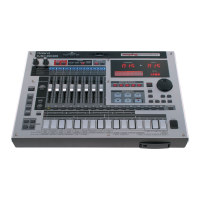32
2. Creating an original pattern
It’s convenient to use the Copy function (p. 71) when you need to
repeat the same data.
1.
Hold down [SHIFT] and press keyboard pad [1].
The Edit Copy screen will appear.
fig.qs-030_50
2.
Make the following settings.
Use [CURSOR ] to select a parameter, and use the
VALUE dial or [INC] [DEC] to set its value.
3.
Press [ENTER].
The Copy operation will be executed; now you’ve created four
measures of data.
By using the Arpeggio function (p. 53) you can play a complex
melody in real time just by pressing a simple chord.
Prepare for recording
1.
Select part 3.
2.
Press [REC].
The recording menu screen will appear.
3.
Use [CURSOR ] to select “Realtime Rec,” and press
[ENTER].
You’ll be in realtime recording standby mode.
fig.qs-022_50
4.
Press [PLAY] to begin recording.
Now you can record.
Enter an arpeggio
1.
Press [ARPEGGIO] so it’s lit.
fig.qs-031_50
2.
Select an arpeggio style.
Hold down [ARPEGGIO] and turn the VALUE dial or use
[INC] [DEC] to select “ARP Preset 092.”
fig.qs-036_50
3.
At the first beat of measure 1, simultaneously press
keyboard pads 2, 5, 7, 9, and 10, and continue holding down
these pads until the fourth beat of measure 4.
Release the pads when the fourth beat of measure 4 has ended.
Stop recording
1.
Press [STOP] to stop recording.
2.
Press [ARPEGGIO] to turn off its illumination.
2-2-3 Turning one measure of data
into four measures (Copy)
Parameter
Value
Copy Src
Source From
1
Source End 1
Event ALL
Min –
Max –
Copy Dest
Dest Pattern
User
800 (number of the selected pattern)
Dest Measure 2
Dest Part –
Copy Mode REPLACE
Copy Times 3
2-2-4 Using the Arpeggio function
for realtime recording
MC-808_r_e.book 32 ページ 2007年7月17日 火曜日 午後5時1分

